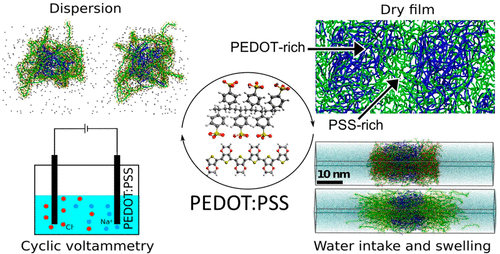当前位置:
X-MOL 学术
›
Macromolecules
›
论文详情
Our official English website, www.x-mol.net, welcomes your
feedback! (Note: you will need to create a separate account there.)
Microscopic Understanding of the Granular Structure and the Swelling of PEDOT:PSS
Macromolecules ( IF 5.1 ) Pub Date : 2020-07-28 , DOI: 10.1021/acs.macromol.0c00877 Mohsen Modarresi 1 , Aleksandar Mehandzhiyski 2 , Mats Fahlman 2 , Klas Tybrandt 2 , Igor Zozoulenko 2
Macromolecules ( IF 5.1 ) Pub Date : 2020-07-28 , DOI: 10.1021/acs.macromol.0c00877 Mohsen Modarresi 1 , Aleksandar Mehandzhiyski 2 , Mats Fahlman 2 , Klas Tybrandt 2 , Igor Zozoulenko 2
Affiliation

|
The conjugated polymer poly(3,4-ethylenedioxythiophene) polymerized and stabilized in the presence of polystyrenesulfonate (best known as PEDOT:PSS) is a working horse of organic electronics and bioelectronics and one of the most important conductive polymers. While its morphology is complex and depends on the details in synthesis and post-treatment, its distinctive and common feature is a two-phase granular structure attributed to PEDOT- and PSS-rich regions. Yet, there is still no well-established consensus concerning the precise nature of PEDOT- and PSS-rich regions as well as their chemical composition and structure. In this study we perform coarse-grained MARTINI molecular dynamics simulations of PEDOT:PSS focusing on understanding its two-phase morphology as well as water intake and ion exchange. We demonstrate that PEDOT:PSS is an essentially three-component system consisting of positively charged PEDOT chains, PSS chains with mostly deprotonated sulfonate groups, and protonated PSS chains. PEDOT-rich regions are predominantly composed of PEDOT and deprotonated PSS chains, whereas PSS-rich regions are composed of protonated PSS chains. Our calculations unravel how PEDOT- and PSS-rich regions are formed from the solution phase during the drying process. We show that when the dry polymer film is immersed in water, its swells by nearly 60%, and we demonstrate that the origin of swelling is related to deprotonation of the sulfonate groups in the PSS-rich regions. It is mostly PSS-rich regions that swell while the PEDOT-rich regions remain rather unchanged. We demonstrate that swelling of the film is rather insignificant during reduction/oxidation within the cyclic voltammetry (CV) conditions. We show that during CV experiments each counterion brings on overage ≈4 water molecules into the polymer region. Our simulations of swelling, CV experiments, and π–π stacking formation in PEDOT and PSS match well the experimental results. Our theoretical studies unravel the most important morphological aspects of one of the most important polymers for organic electronics, providing the essential insight needed for the material and device design and improvements.
中文翻译:

对PEDOT:PSS的颗粒结构和膨胀的微观理解
在聚苯乙烯磺酸盐(最著名的是PEDOT:PSS)存在下聚合并稳定化的共轭聚合物聚(3,4-乙撑二氧噻吩)是有机电子和生物电子领域的佼佼者,也是最重要的导电聚合物之一。虽然它的形态很复杂,并且取决于合成和后处理的细节,但它独特而又共同的特征是归因于PEDOT和PSS丰富区域的两相颗粒结构。然而,关于富含PEDOT和PSS的区域的确切性质以及它们的化学组成和结构,尚未达成公认的共识。在这项研究中,我们进行PEDOT:PSS的粗粒度MARTINI分子动力学模拟,重点是了解其两相形态以及吸水和离子交换。我们证明PEDOT:PSS是基本上由三部分组成的系统,由带正电的PEDOT链,带有大部分去质子化磺酸盐基团的PSS链和质子化的PSS链组成。富含PEDOT的区域主要由PEDOT和去质子化的PSS链组成,而富含PSS的区域由质子化的PSS链组成。我们的计算揭示了在干燥过程中溶液相如何形成富含PEDOT和PSS的区域。我们显示出,当干聚合物薄膜浸入水中时,其溶胀率接近60%,并且我们证明了溶胀的起源与PSS富集区域中磺酸盐基团的去质子化有关。大部分是PSS富集区域膨胀,而PEDOT富集区域则保持不变。我们证明了膜的溶胀在循环伏安法(CV)条件下的还原/氧化过程中微不足道。我们表明,在恒压实验中,每个抗衡离子都会将过量的约4个水分子带入聚合物区域。我们在PEDOT和PSS中进行的溶胀,CV实验和π–π堆积形成的模拟与实验结果非常吻合。我们的理论研究揭示了有机电子最重要的聚合物之一的最重要的形态学方面,提供了材料和器件设计及改进所需的基本见识。PEDOT和PSS中的π–π堆积形成与实验结果非常吻合。我们的理论研究揭示了有机电子最重要的聚合物之一的最重要的形态学方面,提供了材料和器件设计及改进所需的基本见识。PEDOT和PSS中的π–π堆积形成与实验结果非常吻合。我们的理论研究揭示了有机电子最重要的聚合物之一的最重要的形态学方面,提供了材料和器件设计及改进所需的基本见识。
更新日期:2020-08-11
中文翻译:

对PEDOT:PSS的颗粒结构和膨胀的微观理解
在聚苯乙烯磺酸盐(最著名的是PEDOT:PSS)存在下聚合并稳定化的共轭聚合物聚(3,4-乙撑二氧噻吩)是有机电子和生物电子领域的佼佼者,也是最重要的导电聚合物之一。虽然它的形态很复杂,并且取决于合成和后处理的细节,但它独特而又共同的特征是归因于PEDOT和PSS丰富区域的两相颗粒结构。然而,关于富含PEDOT和PSS的区域的确切性质以及它们的化学组成和结构,尚未达成公认的共识。在这项研究中,我们进行PEDOT:PSS的粗粒度MARTINI分子动力学模拟,重点是了解其两相形态以及吸水和离子交换。我们证明PEDOT:PSS是基本上由三部分组成的系统,由带正电的PEDOT链,带有大部分去质子化磺酸盐基团的PSS链和质子化的PSS链组成。富含PEDOT的区域主要由PEDOT和去质子化的PSS链组成,而富含PSS的区域由质子化的PSS链组成。我们的计算揭示了在干燥过程中溶液相如何形成富含PEDOT和PSS的区域。我们显示出,当干聚合物薄膜浸入水中时,其溶胀率接近60%,并且我们证明了溶胀的起源与PSS富集区域中磺酸盐基团的去质子化有关。大部分是PSS富集区域膨胀,而PEDOT富集区域则保持不变。我们证明了膜的溶胀在循环伏安法(CV)条件下的还原/氧化过程中微不足道。我们表明,在恒压实验中,每个抗衡离子都会将过量的约4个水分子带入聚合物区域。我们在PEDOT和PSS中进行的溶胀,CV实验和π–π堆积形成的模拟与实验结果非常吻合。我们的理论研究揭示了有机电子最重要的聚合物之一的最重要的形态学方面,提供了材料和器件设计及改进所需的基本见识。PEDOT和PSS中的π–π堆积形成与实验结果非常吻合。我们的理论研究揭示了有机电子最重要的聚合物之一的最重要的形态学方面,提供了材料和器件设计及改进所需的基本见识。PEDOT和PSS中的π–π堆积形成与实验结果非常吻合。我们的理论研究揭示了有机电子最重要的聚合物之一的最重要的形态学方面,提供了材料和器件设计及改进所需的基本见识。













































 京公网安备 11010802027423号
京公网安备 11010802027423号